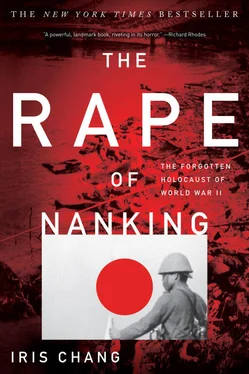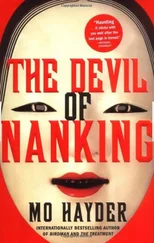If this story had come out during the Japanese war tribunals, it might have implicated the royal family and military command alike for their failure to crack down on war criminals when news of misdeeds reached them. (Mikasa admitted that he reported on the China situation in “bits and pieces” to his brother the emperor and even watched with him a newsreel about Japanese atrocities in China.) But Mikasa’s confession did not emerge until 1994—almost half a century after the IMTFE.
We will probably never know exactly what news Hirohito received about Nanking as the massacre was happening, but the record suggests that he was exceptionally pleased by it. The day after the fall of the Chinese capital, the emperor expressed his “extreme satisfaction” to Prince Kanin, the grand-uncle of the empress and chief of the army general staff, and the prince, in turn, sent a telegram of congratulations to Matsui Iwane: “Not since history began has there been such an extraordinary military exploit.” Hirohito even invited Matsui, Asaka, and Yanagawa to his summer villa to present them with silver vases embossed with the imperial chrysanthemum.
In the end, the royal family not only escaped scrutiny at the tribunal but went on to enjoy lives of leisure and national adoration. Prince Asaka, for one, retired to watch weekly newsreels with Hirohito, to sit with him on the Council of Princes of the Blood, and to play golf with him until the end of his days. (Asaka not only excelled at the sport but took an active interest in golf course development, becoming the architect of the Plateau Golf Course at the Dai-Hakone Country Club, in the resort town of Hakone on the east coast of Japan.) Hirohito himself lived peacefully and in dignity until his death in 1989.
9. THE FATE OF THE SURVIVORS
MORE THAN one scholar of the Nanking massacre has commented upon the dismal manner in which justice was doled out after the IMFTE. While many of the Japanese who tormented the Nanking citizens received full military pensions and benefits from the Japanese government, thousands of their victims suffered (and continue to suffer) lives of silent poverty, shame, or chronic physical and mental pain.
The pivotal moment in this reversal of justice came with the advent of the cold war. The United States had originally sought to implement democracy in Japan by purging Japan’s leadership of people involved in the war. But after the war the Soviet Union broke its promises at the Yalta Conference and seized Poland and part of Germany. As the “iron curtain” of communism descended on Eastern Europe, so did a “bamboo curtain” in China; in 1949 the Communist forces of Mao Tse-tung defeated the armies of Chiang Kai-shek, forcing his government to retreat to the island of Taiwan. Then in 1950 the Korean War broke out, eventually killing 1 million Koreans, a quarter-million Chinese, and thirty-four thousand Americans. With China, the Soviet Union, and North Korea as its new postwar enemies, the United States suddenly viewed Japan as a country of strategic importance. Washington decided to maintain a stable government in Japan in order to better challenge communism in Asia. The United States left the prewar bureaucracy in Japan virtually intact, permitting many of its wartime perpetrators to go unpunished. Therefore, while the Nazi regime was overhauled and replaced and numerous Nazi war criminals were hunted down and brought to trial, many high-ranking wartime Japanese officials returned to power and prospered. In 1957 Japan even elected as prime minister a man who had been imprisoned as a class A war criminal.
At the same time, most if not all of the Nanking massacre survivors vanished from public view. During the cold war and the turbulent years of Mao’s reign, Nanking—along with the rest of China—remained isolated from much of the international community. The Chinese Communist government not only severed communication with the West for several decades but expelled many of the remaining foreigners in Nanking, even those who had saved thousands of Chinese lives as administrators of the Nanking Safety Zone.
In the summer of 1995 I became one of the first people from the West to capture on videotape the oral testimonies of several survivors of the Rape of Nanking. Sad to say, if I had visited Nanking only a decade earlier, I would have found many sites of the massacre intact, for the city was then a model of historical preservation and much of its 1930s architecture was still standing. But in the late 1980s and 1990s the city underwent a frenzy of land speculation and construction, demolishing most of its ancient landscape and replacing it with new luxury hotels, factories, skyscrapers, and apartment buildings, under thick blankets of smog. Even much of the famous Nanking Wall disappeared, with only a few gates remaining as tourist attractions.
If I did not know about the Rape of Nanking before my visit to this teeming, congested, and thriving city, I would have never suspected that it even took place, for the population of the city was at least ten times greater than it had been immediately after the massacre. Underneath the prosperity, however, hidden from view, were the last human links to the past—the elderly survivors of the Nanking massacre. Scholars in the city guided me to a few of them scattered throughout Nanking.
What I found shocked and depressed me. Most lived in dark, squalid apartments cluttered with the debris of poverty and heavy with mildew and humidity. I learned that during the massacre some had received physical injuries so severe they had been prevented from making a decent living for decades. Most lived in poverty so crushing that even a minimal amount of financial compensation from Japan could have greatly improved the conditions of their lives. Even $100 in reparations from the Japanese to buy an air conditioner could have made a world of difference for many of them.
After the war some of the survivors had clung to the hope that their government would vindicate them by pushing for Japanese reparations and an official apology. This hope, however, was swiftly shattered when the People’s Republic of China (PRC), eager to forge an alliance with the Japanese to gain international legitimacy, announced at various times that it had forgiven the Japanese; in 1991 the PRC government even invited the Japanese prime minister to visit mainland China. Hearing such news was like being raped a second time, and some saw themselves as the victims of a double betrayal—first by the KMT soldiers who fled from Nanking before the city collapsed, then by the PRC government, which sold out their futures to the Japanese.
According to Karen Parker, an international human rights attorney, the PRC has never signed a treaty with the Japanese relinquishing its right to seek national reparations for wartime crimes, despite its conciliatory statements toward the Japanese. Moreover, Parker claims that even if such a treaty is made, it cannot, under the principle of jus cogens, infringe upon the right of individual Chinese people to seek reparations for wartime suffering.
But most of the survivors I spoke with in Nanking did not know the intricacies of international law and therefore believed that the PRC had already forfeited their right to seek reparations. Any news of friendly relations between the Chinese and Japanese governments is emotionally devastating to them. One man who was nearly roasted alive by the Japanese during the Rape of Nanking told me that he wept uncontrollably when he heard rumors that the PRC had forgiven the Japanese their past crimes. Another woman whose father was executed during the Nanking massacre said that her mother collapsed in a faint when the news of the prime minister’s visit reached her over the radio. [3] Not all of the survivors from the Rape of Nanking, however, suffered tragic fates. Sometimes I encountered numerous surprise endings, like the conclusion of the life of commander Tang Sheng-chih. Despite his fiasco at Nanking, Tang went on to enjoy a charmed existence in China. Things were rough for him at first, because the Nanking debacle left him in foul odor with the Nationalist party and forced him to return to his home province of Hunan without an official job. But after the Communists came to power, the new leadership embraced Tang—even though he had been a high-ranking military official in the enemy camp. Swiftly Tang rose to prominence, serving as lieutenant governor of Hunan and a member of the National People’s Congress, the National Defense Committee, the Chinese National Party Revolutionary Committee and number of other organizations. Only after serving a long prestigious career in politics did he finally die on April 6, 1970—a revered official in his eighties.
Читать дальше











